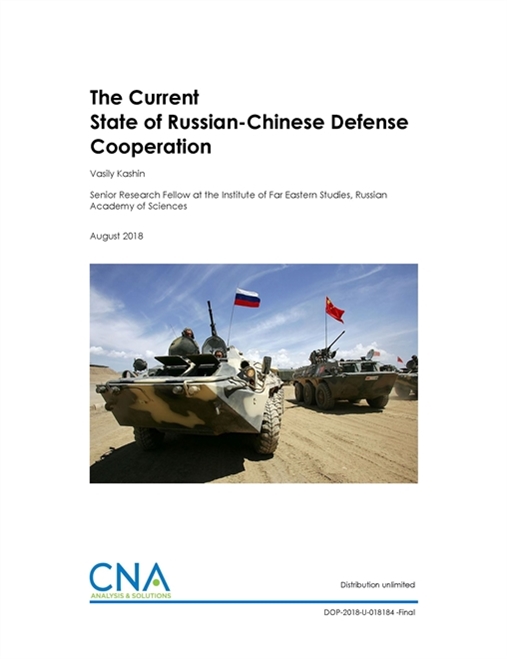Since the normalization of ties between Moscow and Beijing in 1989, defense and security cooperation has been the most important element of the bilateral relationship. For a long time, arms trade and dialogue about regional and border security were the only elements of the relationship that were showing positive dynamics. The other elements, such as bilateral trade, were negligible until the early 2000s. Then, as Russian-Chinese economic cooperation began to grow, defense and security ceased to be the only substantial element of the relationship—but they have remained important.
While the arms trade has seen ups and downs depending on the modernization cycles in the Chinese People’s Liberation Army (PLA), military cooperation has seen steady progress since mid 2000s. The two sides attach great political importance to this cooperation but avoid public discussions about their desired end state. While both sides officially deny that they intend to form an alliance, the scale and nature of their joint activities in the military, security, and defense technology fields are consistent with preparation for possible joint military action against a major hostile country. This paper examines the current state of this cooperation, Russia’s approach to developing it, and the possible outcomes.
Before discussing the current state of cooperation, this paper will describe two mistakes that analysts often make when analyzing Russian-Chinese relations.
- First, they underestimate the very high level of continuity in the two sides’ policies towards each other. Vladimir Putin’s policy towards China is basically a continuation of the course that was laid down by the first president of Russia, Boris Yeltsin, in 1996-1997. Yeltsin’s policy was largely based on approaches developed in the last years of the USSR, during the rapprochement with China started by Mikhail Gorbachev.
- Second, they limit the historical background of the current Russian-Chinese relations to the Cold War era relations between the USSR and the People’s Republic of China (PRC). The story of the alliance and subsequent dramatic break-up of the two Communist giants leads to certain conclusions about the way they look at each other. However, the history of the relationship between Russia and China is much more complicated than that. After being neighbors for more than 300 years, Russia and China have a long and unusual history of relations in the defense field.
- Of all Russia’s relationships with its neighbors, the one with China probably used to be the most peaceful one. At the beginning of their relations, in the 17th century, the two countries fought a long, low-intensity border war (which was won by the Chinese). The next conflicts did not occur until the early 20th century, when the Russian Empire took part in the Eight Powers Intervention into China during the Boxer Rebellion. The most significant conflict was a brief border war during the East China Railroad Conflict (1929). The Soviet-Chinese border skirmishes in 1969 were not very significant militarily—although they had deep political consequences, they can hardly be compared to Russia’s wars against any of its large, or even small, neighbors.
There have been at least five major episodes in history when Russia was consciously arming or trying to arm China in order to change the balance of power in the Pacific. The first such attempt was undertaken during the Second Opium War, when the Russians offered a large number of rifles and cannons to the Chinese in order to repay the British and the French for the defeat in the Crimean War and to strike a good deal with the Chinese. That attempt failed because the Chinese were unwilling to accept the Russian conditions.
Next, in 1896, the Russian Empire and the Qing Empire signed a military alliance treaty; however, it was not observed by either side. Then, in the 1920s, the USSR helped Guomindang to build an army and unify China. In the 1930s, it provided China with significant amounts of weapons and military expertise for fighting the Japanese. In the 1950s, the USSR helped build a new Chinese military and a world- class defense industry, which, even after being seriously weakened during the Cultural Revolution, provided a basis for future Chinese development.
Historical arguments have always played a prominent role in Russian-Chinese relations, and are well known to the bureaucrats who manage the relations on both sides. For them, the history of the relationship is not limited to the Communist era— a short period of ideological alliance that was succeeded by decades of extreme animosity and occasional bloodshed. It is rather a centuries-long story of trade, intrigues, complicated balancing games, hard bargaining, helping each other, cheating each other, and spying on each other, while doing everything possible to avoid a direct conflict. That has been the normal state of the bilateral relations for much of history; the ideological alliance of 1949-1960 and the ideological confrontation of 1960-1989 look like deviations from the norm and are seen that way from both sides.
The current period of defense and defense-industrial partnership began shortly before the USSR collapsed, and was based on the views of global politics in both Moscow and Beijing. It has been the longest and most successful period of cooperation yet, and can have profound consequences for international politics.
Download reportDistribution unlimited. Specific authority contracting number: G-17-54950.
Details
- Pages: 36
- Document Number: DOP-2018-U-018184 -Final
- Publication Date: 8/1/2018
